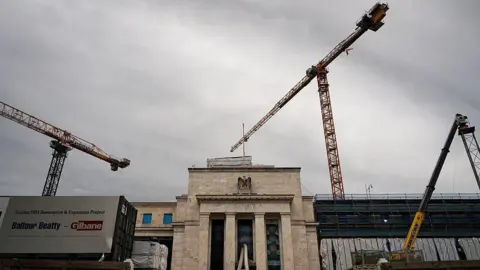In a recent unfolding of events, US President Donald Trump has found himself embroiled in a heated dispute with Jerome Powell, the Chairman of the Federal Reserve (Fed). The contentious back-and-forth has captured public attention, particularly as it took center stage during Trump’s visit to the Fed’s headquarters in Washington, D.C. This visit marks a significant occasion as it is the first by a sitting president in nearly two decades. Trump’s historical context includes his continuous criticisms of Powell via social media and public speeches, branding him with epithets such as “numbskull.”
As cameras rolled, their contentious exchange revolved around the costs of ongoing renovations at the Federal Reserve, which Trump alleged were substantially over budget. This moment coincided with Trump’s escalating demands for lower interest rates, a stance he contends is crucial for stimulating the economy. Despite several threats to fire Powell, Trump has not yet acted on these insinuations, due largely to the potential upheaval that would follow in financial markets and the legal ramifications it could involve. Analysts suggest that such an action would showcase a clear disruption of the Fed’s independence, which is fundamental for its operations.
During this visit, Trump challenged the reported renovation costs, claiming they totaled about $3.1 billion, a figure vehemently rejected by Powell. The Fed chairman clarified that he was unaware of such an inflated budget, indicating it might stem from misconstrued information related to another building project initiated several years prior. The tension highlighted the broader implications of public discourse regarding Fed policies, especially concerning interest rates, which are closely monitored by financial experts and those invested in the market.
Trump’s comments arose in the shadow of a Fed meeting expected to keep interest rates unchanged in the immediate future, a decision anticipated by the markets. While engaging with journalists, Trump expressed frustration with the current $2.7 billion renovation budget, pointing out that delays and cost overruns have plagued the project initially approved in 2017. The project is intended to modernize the Fed’s operations by consolidating two historical buildings dating back to the 1930s. However, reports reveal that budget allocations have shifted due to unforeseen issues such as asbestos removal that have inflated costs significantly over recent years.
The back-and-forth became more intense when Trump was asked how he would respond to an over-budget project if he were managing it. His instinctive response was to suggest he would “fire him,” referring to project managers responsible for overruns. Coupled with his historical context of real estate development, this remark resonates within a broader narrative that has unfolded around Trump’s approach to the economy. Recently, Trump has been vocal about his desire for Powell to implement lower interest rates, arguing this move is essential for minimizing government borrowing costs and easing access to loans for everyday Americans.
Despite his repetitive criticisms targeting Powell and the Fed, Trump’s advisors maintain that this campaign against the Fed is intended to bolster support within his base amidst allegations concerning his past connections to the Jeffrey Epstein case. Democrats claim his criticisms are diversionary tactics, suggesting he may use Powell as a scapegoat if the economy takes a downturn due to unforeseen influences on economic stability exacerbated by his own administration’s policies.
Further complicating the narrative, Powell has suggested that the economic landscape appears stable enough to warrant a cautious wait-and-see approach rather than drastic policy changes. As economic indicators remain mixed, with inflation around 2.7% in June, the Fed faces the challenge of navigating a complex fiscal environment shaped by Trump’s administration and its varying economic policies. In the wake of this ongoing conflict, both the future of interest rates and the Federal Reserve’s operational independence remain in the nation’s spotlight, leaving many anxious about what these developments entail for the US economy overall.












